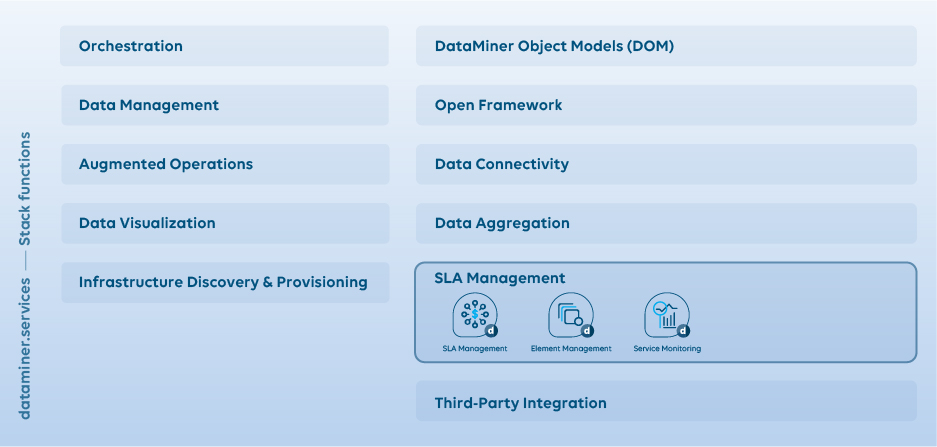Service Management
Reduce operational expenses and ensure that business stakes are always taken into account.

SLA Management
Automate, track, and measure the digital processes that a key relationship depends on.
DataMiner SLA Management is a cutting-edge DataMiner technology that provides operators with a business perspective on their operations. In addition to the typical device and service information, DataMiner SLA Management factors in the historical performance weighed against the defined objectives, providing valuable business impact information.
DataMiner SLA Management allows its stakeholders to manage the SLA for both incoming and outgoing services, as well as Operating Level Agreements (OLA) for the various internal interdependent segments of the corporation. The solution features seamless integration with the existing DataMiner environment (including dashboards, notifications, correlation, mobile access, etc.), which enables users to leverage their existing investments. SLA Management also features a pronounced open architecture, with open XML SLA definitions, user-definable alarm thresholds and interfaces for northbound applications such as trouble ticket platforms.
The design of this powerful module in DataMiner provides a variety of strategic capabilities, including the ability to have different impact ratios for different types of issues (e.g. audio versus video problems on a video service). Another unique feature is the possibility to run new SLA definitions against existing historical data, enabling managers to make well-founded decisions when specifying and committing to service SLAs, or to adapt easily to changing business requirements.
DataMiner SLA Manager features:
- Integrated into the Visual Overview topological graphical user interface, with support for display of real-time SLA readings, and enabling data retrieval from any data source.
- Designed on top of the awarded DataMiner dynamic service technology, which tracks the usage of resources for specific services at runtime. This enables DataMiner SLA Management to take into account the status of any redundancy architecture while calculating SLA compliance, for example.
- Calculates and presents SLA information in real time.
- Open XML format for definition of SLA metrics so that virtually any SLA scheme can be quickly defined and deployed in the operational environment.
- Update SLA definitions at runtime with no interruption of the operational environment.
- Manage both internal and external services, and incoming as well as outgoing services.
- Ability to cater for delay times, and to suspend SLA tracking on services either manually, triggered by user-defined system events, or triggered by a time schedule (e.g. for time-based services or to accommodate for maintenance windows).
- Track key SLA metrics such as total violation time, number of violations and duration of individual violation events.
- Choose to track absolute usage of SLA margins, relative usage of SLA margins, or remaining SLA margins.
- Use predicted compliance to trigger warnings when SLAs have a projected breach at the end of their current evaluation time frame, enabling proactive corrections.
- Configure SLAs for any user-definable time span, supporting both fixed and sliding time windows.
- Real-time SLA Data Display, enabling operators to track in detail all SLA metrics defined in their system.
- User-definable alarm thresholds, to issue early warnings for operators such that appropriate actions can be taken before SLA breaches occur.
- Ability to send email and text message notifications when certain important user-defined SLA events occur.
- Forward SLA-related events and alarms to third-party applications (e.g. trouble ticket applications, alarm managers, reporting applications, etc.).
- Trending of SLA metrics (e.g. available time) for detailed historical analysis, with features to load trend graphs, to export trend information to spreadsheets, etc.
- User-definable SLA web dashboards, showing a summary overview of all SLAs, including real-time readings of key metrics.
- Intelligent correlation of SLA events (e.g. automatically escalate SLA events that remain unresolved for too long, escalate alarms on non-operational backup devices when SLAs exhibit poor condition, automatically re-allocate backup resources to services exhibiting a poor SLA status, etc.).
Tip
For more information:
Service Monitoring
Monitor the performance of different services and quickly detect and resolve any issues.
DataMiner provides unprecedented visibility over your operation by offering a dynamic service layer on top of the multi-vendor infrastructure management layer that subsequently traces any services, right across any vendor and technology boundaries, resulting in a unique real-time and historical service perspective on the most complex operations.
Users have the possibility to see the network in a way that suits them more. They can design building blocks using Microsoft Visio drawings and link them to real-time information in order to have a service path view.
DataMiner monitors service compliance and quality at any point in the infrastructure. The information collected may come from dedicated monitoring probes or from processing hardware/software functions. The information can be collected based on polling, alarm notifications, or active synthetic testing.
Tip
For more information:
- Demo video: DataMiner Services Explained

- Advanced video: DataMiner service templates

- Video: Service-Aware Confidence Monitoring

- Services and service templates
Element Management
Manage network elements on the network element management layer.
Tip
For more information: